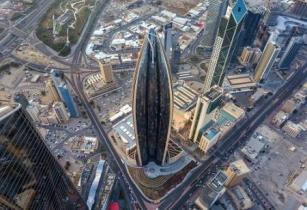thyssenkrupp Elevator has installed 10 TWIN elevator systems at National Bank of Kuwaits new head office
Located in the heart of Kuwait City, the new pearl and shell-shape inspired head office for the National Bank of Kuwait (NBK) consists of 63 floors and stands at a height of 300 meters, making it the country?s second tallest building and a remarkable new landmark in the city?s skyline. TWIN is the only elevator system with two cabins that move independently in one single shaft, making the most efficient use of available space, using less energy, and quickening the pace of building tenants. The five-year contract includes maintenance support with access to a stand-by technician.
According to the company, each elevator has its own traction drive, controller, ropes, counterweight and governor, while also sharing the same guide rails and landing doors. The key to this system?s safety is that the cabins always operate at a minimum safety distance. It is fully certified by the German T?V inspectorate ? the most stringent and rigorous safety standard an elevator can attain.
The project was built in line with LEED Gold requirements, one of the first with such high certification in Kuwait. Apart from the 10 TWIN elevator systems, thyssenkrupp Elevator has also installed 12 conventional elevators, some of which can travel up to 6 meters per second, as well as one panoramic elevator and two escalators.
Mobility throughout the entire building is promoted via thyssenkrupp Elevator?s destination selection control (DSC) software, AGILE. Unlike conventional operation, a floor is chosen at the AGILE terminals in front of an elevator group and the intelligent dispatching software analyses the request ? gauging traffic demand and grouping passengers based on similarity of destination. This leads to less crowding, fewer stops, and a more efficient use of available elevator capacity.





